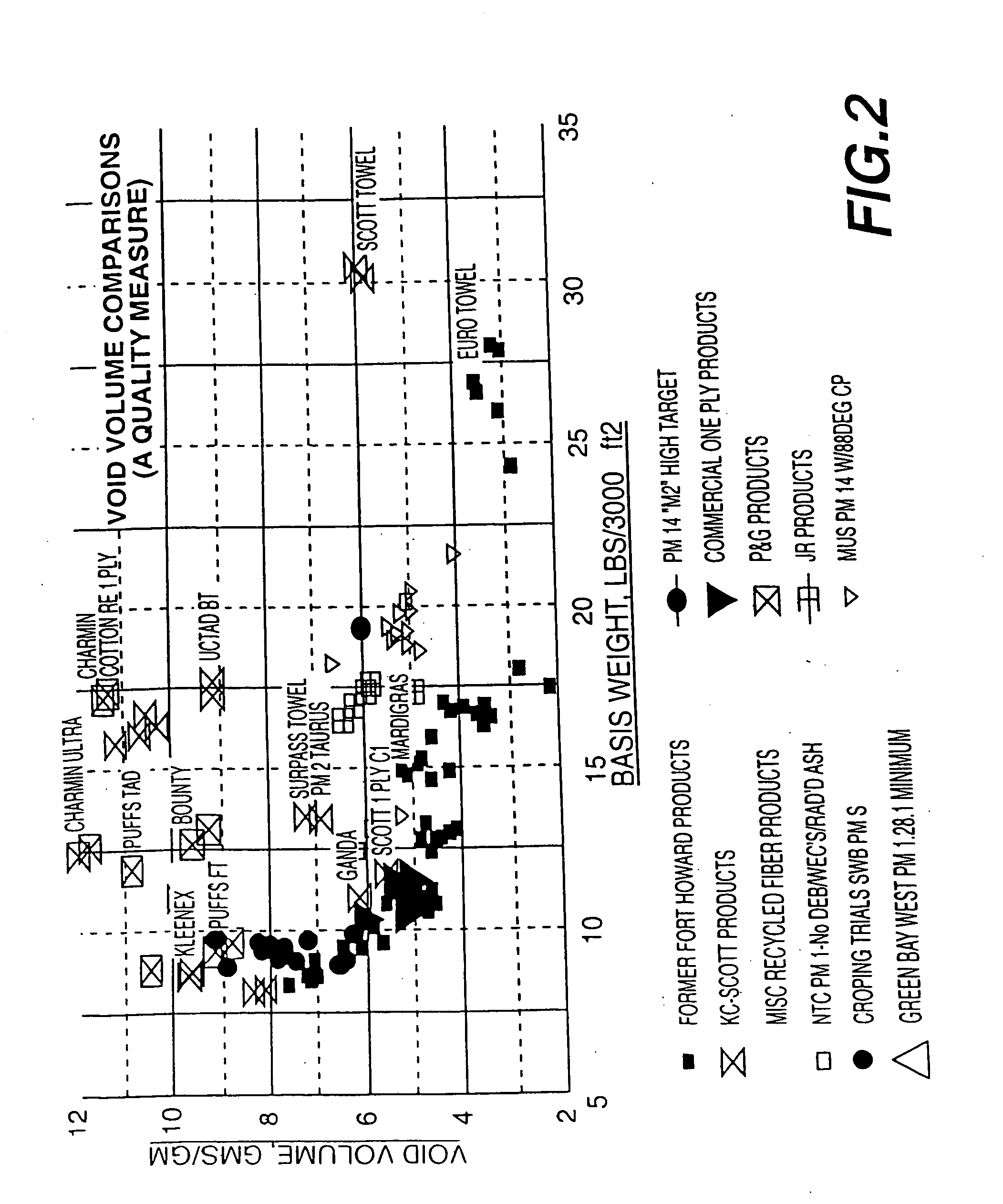Method of making a paper web having a high internal void volume of secondary fibers
a secondary fiber and internal void volume technology, applied in papermaking, non-fibrous pulp addition, transportation and packaging, etc., can solve the problems of difficult to make soft absorbent paper webs having sufficient strength, softness and absorbency to qualify as premium or near-premium quality without resorting to more expensive, and imposes marked economic disadvantages over single-ply paper tad sheets
- Summary
- Abstract
- Description
- Claims
- Application Information
AI Technical Summary
Benefits of technology
Problems solved by technology
Method used
Image
Examples
example 5
[0239] A web was made in accordance with Example 2, except for the differences noted below. To the wet end of the paper making machine was added 3.5 lbs / ton of Quasoft 230, 4 lbs / ton of Cytec 573, a low-molecular-weight high charge density quaternary ammonium polymer from Cytec Industries, Inc., and 0.5 lbs / ton of Nalco 7520 retention aid. The creping angle was increased to 82° and the Yankee adhesive was changed to Solvox 4450, a polyamineamide-epichlorohydrin resin adhesive available from Solvox Manufacturing Co., Milwaukee, Wis. and which was applied to the Yankee at a rate of 0.72 lbs / ton. The rate of application of the release agent was dropped to <0.05 lbs / ton and the crepe percent was reduced to 20%.
[0240] The base sheet web produced had a basis weight of 18.6 lbs / 3000 sq. ft2. The MD tensile of the web was 440 g / in, the CD tensile was 120 g / in, the GM tensile was 230 g / in, and the void volume was 6.6.
[0241] The finished, converted product had the following attributes:
Bas...
example 6
[0245] Towel with a basis weight in the range of from 12 to 30 lbs / ream is made from a furnish containing significant amounts of ash and fines by combining fiber containing a significant amount of ash and fines, usually a recycled fiber, with water to form a furnish. A charge modifier is added to the furnish at a point of high consistency, preferably above about 3%, and the furnish is mixed well, such as a pump inlet. The charge modifier is added before any strength-adjusting agent is added. The charge modifier is added at a rate so that the anionic charge on the through-80-mesh fraction of the furnish is reduced, e.g., to 30% of its original value. The charge modifier is added in an amount of from about 1 lb / ton to about 10 lb / ton, with preferred rates being 2 to 8 lbs / ton.
[0246] Next, a cationic strength-adjusting agent is added to the furnish. The strength-adjusting agent is added at a rate sufficient to generate the level of CD wet tensile desired without causing the suspended ...
example 7
[0248] A napkin product is formed from a web made with a pulp to which is added water to form a thick stock. To the thick stock is added a charge modifier in an amount sufficient to reduce the anionic charge on the through-80-mesh fraction of the furnish to about <30% of its original value. The charge modifier is added in an amount of from about 1 lb / ton to about 10 lbs / ton, more preferably 1 lb / ton to about 6 lbs / ton. If wetting disintegration resistance is required, a wet strength adjusting agent may be added. This is added in an amount sufficient to generate the level of CD wet tensile desired without taking the charge on the suspended solids cationic as measured at the headbox. If a wet strength adjusting agent is added, it is preferably added in an amount of from about 1 lb / ton to about 10 lbs / ton. Auxiliary agents may also be used. Auxiliary agents are preferably added in an amount of from about 2 lbs / ton to about 7 lbs / ton.
[0249] A softener or debonder is also an optional co...
PUM
| Property | Measurement | Unit |
|---|---|---|
| depths | aaaaa | aaaaa |
| weights | aaaaa | aaaaa |
| basis weights | aaaaa | aaaaa |
Abstract
Description
Claims
Application Information
 Login to View More
Login to View More - R&D
- Intellectual Property
- Life Sciences
- Materials
- Tech Scout
- Unparalleled Data Quality
- Higher Quality Content
- 60% Fewer Hallucinations
Browse by: Latest US Patents, China's latest patents, Technical Efficacy Thesaurus, Application Domain, Technology Topic, Popular Technical Reports.
© 2025 PatSnap. All rights reserved.Legal|Privacy policy|Modern Slavery Act Transparency Statement|Sitemap|About US| Contact US: help@patsnap.com



